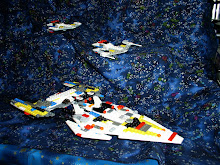This week, I want to go back over the anti-virus for a bit. It’s very important that not only do you have anti-virus, but also that you keep it updated and know how to run it.
I’m going to concentrate on AVG Free, because that’s what I use. If you use something else (Avira, Avast, PC-Cillin, Norton, McAfee, whatever) the basic steps should be similar.
First, open the program by double-clicking on AVG’s icon in the system tray. It looks like a little red, yellow, blue and black quilt square. It’ll open up with seven icons in the main screen, and three tabs on the left side, one of which is the Overview tab. All the icons on the Overview should be marked as Active and have a green check by them. If they don’t, click on the Update Now tab. It’ll tell you that it is updating and then go download any updates it needs if there are new ones. Otherwise it tells you No ne3ed updates are available. Once it is done, go to the Computer Scanner tab. This one isn’t quite so obvious as to what exactly you are supposed to do here. One icon is “Scan whole computer,” and has “Change scan settings” in blue under it. If you click on that, you will find that there is a “Start Scan” button on the lower right. Click that and go watch TV, read a book, check your email. In a stock Windows XP install, there are over 125,000 files. Depending on the speed of your CPU, this can take anywhere from 45 minutes to a couple of hours.
Right off the bat, it’ll find what are called Tracking Cookies. Don’t panic! For the most part, overwhelmingly, these cookies are harmless. Cookies are small text files (they can’t do anything on their own) that tell a web site what your preferences are and in some rare cases, what web sites you go to. Only the site that put it there can read them, or a site that knows the exact location and name of the cookie, which is rather unlikely. If it finds other stuff, like java Trojans, AVG will let you know in the Scan Results window. Mine just finished now, and it found (even with my careful habits) four infected files that were promptly healed. These were files that I thought had been downloaded from reputable sources or from friends that I thought knew what they were doing. There was no spyware found, and 27 tracking cookies were found. AVG Free scanned 607720 files (I keep just about everything and backup other computers to this when needed. I’ve been online in some form since about 1988.), and it took 1 hour, 7 minutes and 30 seconds. Overall, no harm done to my computer by anything AVG found.
On the Infections tab under Scan Results, you will find a “Remove all unhealed infections” button. I don’t have any right now. In my case, I am going to let AVG remove these even though it has moved them to the Virus Vault where they are inactive. I closed the results page and now will go to History and then Virus Vault. Anything here does not need to stay on your computer. Click “Empty Vault” to make them go away, and then “OK” to close.
With that, you can close AVG and go on happily computing.
To get rid of the Cookies, the easiest way is to open Internet Explorer (we’ll get to Firefox in a second) and go to Tools, Internet Options, and under Browsing History, click the Delete button. If you use IE to save passwords, do not click Delete All at the bottom. Just click the ones that apply. I don’t allow IE to remember anything; your habits may vary. This operation may take a few seconds.
For Firefox, click Tools, and then Clear Private Data. Make sure the Cookies check box is selected, and then click “Clear Private Data Now.” When that dialog box vanishes, it’s done.
SUPER AntiSpyware (yes, that is what it’s called…) does not update automatically, but there is a nice button at the bottom of the first column that says, “Check for Updates.” It’ll tell you what it’s doing and then install those. Once it’s done, click the “Scan You Computer” button. SUPER will ask you what hard drives you want to scan. It should have installed drives already selected, though you can remove the check on any drives you don’t want scanned. I let it scan both hard drives in this computer. Then, click in the circle by “Perform Complete Scan.” You can go to “Perform Quick Scan” in later scans. Then, click “Next” to continue.
Again, this will take a while. So get that book and sit back, or go off and do something else. You can watch and see what it does, though most of the files will be arcanely named Registry entries and stuff most people don’t want to see. Running this will also double-check the results from AVG. Anti-spyware software all works differently, so it’s good to have two that can cover each other. I’m only 10 minutes into this scan, and I deleted files from both IE and Firefox and SUPER still has found 49 tracking cookies already.
Not quite as long, only 24 minutes. The Summary page will pop up. Click “OK,” and then “Next.” SUPER will then remove or quarantine anything it deems harmful. Click “OK” again when it says that operation is complete, and then “Finish.” You can now close SUPER AntiSpyware.


No comments:
Post a Comment